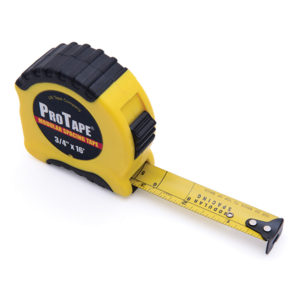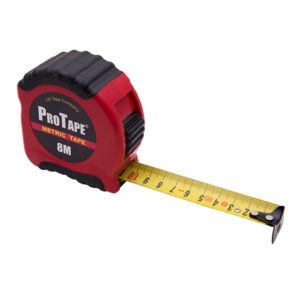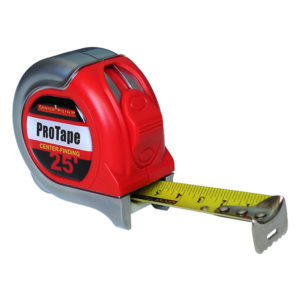
Hidden Features of Measuring Tape
Are you getting the most out of your tape measure?

That might seem like a silly question. After all, a measuring tape is a simple device with a simple – although important – purpose: to measure things.
But there’s more to this tool than meets the eye. Here are a few hidden features you will find within your tape measure.
1. THE CURVE
Have you ever wondered why the blade on a tape measure is curved? The concave design helps keep the blade rigid when extended. This curve allows the blade to “stand out” while measuring, helping you read the measurement.
2. THE BLACK DIAMONDS
The black diamonds which appear every 19 3/16” on metal tape measures are for spacing I-beam “timbers.” Several wood-product manufacturers offer I-beam “timbers” as a substitute for solid lumber floor joists.
The diamond marks on tape rule blades are for spacing these engineered floor joists in new construction. Because these beams can support more weight than their dimensional lumber counterpart, they often have different spacing requirements.
Span tables for these beams provide ratings for spacings of 12”, 16”, 19 3/16”, and 24”. If you multiply these dimensions by 8, 6, 5, and 4, respectively, you’ll find each comes to 96”, the length of the plywood panels used for sub-flooring.
Those diamond marks are there for builders who want to take advantage of the great strength of engineered I-beams by using fewer floor joists, with no loss of floor support.
3. THE NAIL GRAB
 On nearly every measuring tape, you’ll find a small slot on the end hook. It’s there to grab onto the end of a nail or screw.
On nearly every measuring tape, you’ll find a small slot on the end hook. It’s there to grab onto the end of a nail or screw.
This way, if you’re measuring a flat surface and don’t have anyone to hold the other end of the tape, you just need to hammer in a nail or insert a screw and hook the end of the tape onto it to get a clear and accurate measurement.
4. THE SCRIBING TOOL
Did you ever notice that the bottom of the end hook of your measuring tape has a serrated edge? There’s a good reason for that. If you’re measuring something and don’t have a marking tool handy, you can use this serrated edge to make a mark by running it back and forth on whatever you’re measuring.
5. THE ADJUSTABLE END
 The metal tip at the end of your tape measure is a little bit loose for a reason. The first inch of the tape is short by 1/16 of an inch. This isn’t an error: it’s meant to provide you with accurate readings whether you’re measuring the inside or outside edge of a surface. This feature is known as “true zero”.
The metal tip at the end of your tape measure is a little bit loose for a reason. The first inch of the tape is short by 1/16 of an inch. This isn’t an error: it’s meant to provide you with accurate readings whether you’re measuring the inside or outside edge of a surface. This feature is known as “true zero”.
The metal tip is exactly 1/16 of an inch thick. If you’re measuring the outside of a surface and hook your metal end on the edge, that metal piece will shift out and create a gap, so that you aren’t counting it in your measurement.
And if you need to measure the inside of a surface – like in a window frame, you want to count the thickness of the metal piece in your calculations. Thus, the metal piece will shift back to fill the gap. Always take care to pull or push your tape so that it’s taut to take advantage of the true zero feature.
If you’re in the market for a new tape measure, turn to U.S. Tape. We’ve been providing professional grade tape measures for more 140 years in a range of scales, lengths and durable cases.



